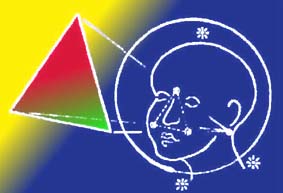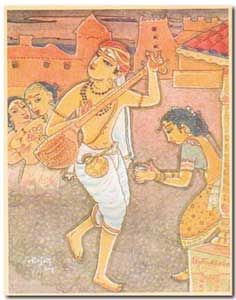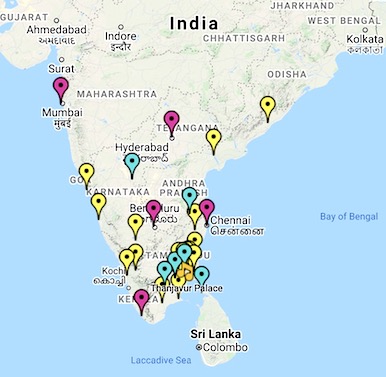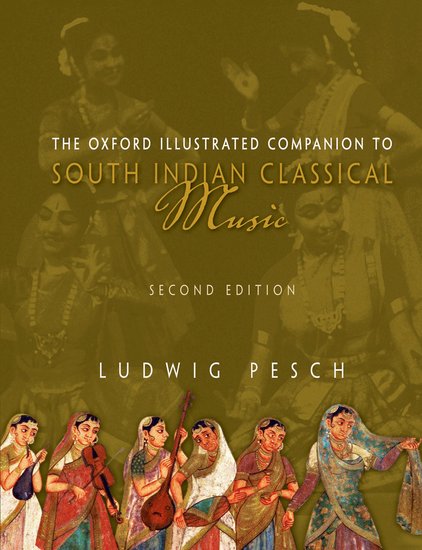
Carnatic music, the art music of South India, is locally known as karnātaka sangītam. According to V. Sriram, an authority on the recent history of this music, a popular interpretation of karnataka sangitam is derived from the Tamil words karna (“ear”) and ata (a word used to express surprise): “that which haunts the ear.” Carnatic music is performed during regular concerts, and also forms part of auspicious occasions such as marriages or temple festivals.
If South Indian musicians and listeners are reputed to have a rather conservative outlook, this has little to do with their music as such. This said it is also true that senior musicians are held in high esteem, and there are ancient customs that continue to be observed in secular India alongside “scientific” or “rational” practices that point to a more humanistic outlook.1 Respect for tradition and reverence for elders certainly permeate the field of music and dance education, the prevalence of syllabus-based institutional and distance education notwithstanding:

The Indian education system boasts of a past where knowledge was imparted to the next generation by word of mouth. To pass on the teachings of various art forms, the masters devised various techniques.2
Festivals rooted in an agrarian society are being celebrated wherever Indians have settled in pursuit of their careers. Already under colonial rule, the southern elite had gravitated towards metropolitan areas in search of higher education and career opportunities; and for many, this meant getting involved in the struggle for civil liberties. These factors and the ensuing migration to foreign countries paved the way for renewed interest in Carnatic music.3
Growing mobility combined with urban lifestyles and universal access to mass media account for many changes such as teaching methods and the role of the mass media as regards patronage. These factors also explain a sense of nostalgia surrounding the idea of a “Golden Age”: a period marked by both, creativity and consolidation, an age heralded by the “Trinity” of early 19th century composers and the “Tanjore Quartet” – four brothers credited with perfecting South India’s dance repertoire as we know it today. For many 2nd and 3rd generation “Non-resident Indians and persons of Indian origin”4 – even those who rarely, if ever, visit India – Carnatic music and Bharatanatyam instantly evoke the culture of their ancestral lands, which may be prompted by lyrics and themes associated with legendary personalities or historical events; and eventually, these associations contributed to the “cultural atmosphere” prevailing among members of certain communities and linguistic minorities to this very day. 5

For instance, some family traditions (bāni) continue to be identified with certain places or regions where the ancestors of their present exponents lived, notably Tanjavur, Karaikudi, Palghat, and Mysore.6
Going by the number of forum discussions on the internet, there is also an insatiable appetite for new concert and dance compositions. Carnatic concerts provide all the scope required for artistic self-expression and spontaneity, yet venerable traditions continue to flourish.
Should we therefore regard this music as the preserve of a privileged few? Even if some may be inclined to think so, for reasons only known to themselves, there are good reasons to think otherwise.7
If this question goes beyond the purview of “classical music”, this is echoed in the words of one of India’s most outspoken writers of the 20th century:
I see one India in the pattern. You see another. Light and shadow play. History and modernity collide. […] I cling to the belief that for any culture as old and ancient as ours to have survived over time and in time, there could only be one basic common and acceptable core thought: humaneness. To accept each other’s right to be human with dignity.8
Mahasweta Devi is remembered for her commitment to the humanitarian causes embraced by her country’s founding fathers. In the words of Nobel-Laureate Rabindranath Tagore, who was greatly attracted to Carnatic music from a young age:
When our self is illuminated with the light of love, then the negative aspect of its separateness with others loses its finality, and then our relationship with others is no longer that of competition and conflict, but of sympathy and co-operation.9
According to Reba Som, Tagore was “attracted by the distinctive styles of regional music [and] wrote about the great evocative power of tunes wafting across distances–carrying the message of an unknown address whispered in the ear by a traveller–bringing a note of hope and encouragement across oceans of divide.”10
In short, Carnatic music not merely “survives” but keeps flourishing in myriad ways, being interwoven with the customs and hopes of people in different parts of India and beyond. This is why it is not limited to just one particular way of being in the world, on the contrary:
Tyagaraja worried about many things. […] But he did not worry for music except that it should not be divorced from bhakti. […] Even the brilliant Semmangudi Srinivasa Iyer, who was himself deeply religious, clarified that bhakti is essential for a Carnatic music, but this bhakti is for music, not for any personal deity.11
More recently, Nobel-Laureate Amartya Sen noted how the ‘openness’ Rabindranath Tagore valued so much comes under great strain – in many countries including India: “Tagore would see the expansion of religious sectarianism as being closely associated with an artificially separatist view of culture.”12
His contemporary, the celebrated poet and “The Eternal Revolutionary” Subramania Bharati (1882-1921) shared Tagore’s “ideals of culture, nature, and humanism” whereby “nationalism could never mean a turning inward, a focus on national interest in the narrow sense, to the exclusion of the world at large”. Not surprisingly, noted Carnatic musicians have set his poetry to music in order to express a shared sense of social justice and non-violence in service of India’s Independence and fostering an “uncompromising commitment to principles of equality – gender, caste, religion, nationality, race, and even age”.13
Some clarifications on caste-related issues by reputed scholars >>
So the most rewarding task for teachers and performers may well be to convey Tyagaraja’s last message to his disciples and the world, one that may liberate us by letting go of artificially separatist views of culture, creed and nature as well (given the multiple crises humankind is faced with on a daily basis):14
Paramātma is brightly shining / may this dawn upon you / in all its beauty / Named as Vishnu, named as Shiva / Said to be in people / and heavenly beings / throughout the entire universe / That Supreme Being pervades like light! / Have a joyful subtle insight into that / in all its beauty.
Text: Ludwig Pesch
Learn & practice more
A brief introduction to Carnatic music (with music examples and interactive map)
Bhava and Rasa explained by V. Premalatha
Free “flow” exercises on this website
Introduction (values in the light of modernity)
Video | Keeping tala with hand gestures: Adi (8 beats) & Misra chapu (7 beats)
Why Carnatic Music Matters More Than Ever
Worldcat.org book and journal search (including Open Access)

Find a copy of the Oxford Illustrated Companion to South Indian Classical Music by Ludwig Pesch
- from Oxford University Press
- from an Indian online bookstore
- in a library near you via WorldCat.org
- The Indian constitution defines India as a “Sovereign Socialist Secular Democratic Republic with a parliamentary system of government“; as summarized by historian Ramachandra Guhan, the Constitution would guarantee citizens “justice, social, economic and political; equality of status; of opportunity, and before the law; freedom of thought, expression, belief, faith, worship, vocation, association and action, subject to law and public morality.” [↩]
- A. Sangameswaram in “Preserving a rich cultural tradition”, The Hindu, 14 September 2007 [↩]
- Sunil Khilnani describes the near-official status of the great singer M.S. Subbulakshmi, namely “as an icon of independent India”, in his series of radio programmes titled “Incarnations: India in 50 Lives” which is available as podcast and on BBC Radio 4, also in book form [↩]
- According to Wikipedia, “Overseas Indians, officially known as Non-Resident Indians (NRIs) or Persons of Indian Origin (PIOs), are people of Indian birth, descent or origin who live outside the Republic of India.” [↩]
- The tension created by “transnational ethnic identities, the process of travel and resettlement” is discussed by Anita Kumar in her essay titled “What’s the Matter? Shakti’s (Re)Collection of Race, Nationhood and Gender”, in Bharatanatyam: A Reader edited by Davesh Soneji (Oxford University Press 2010), pp. 325 [↩]
- For a vivid account, read the chapter titled “Songs from the soul: 1805–1847” in Modern South India: A History from the 17th Century to our Times by Rajmohan Gandhi [↩]
- “Musicians and listeners must have been aware long before the abstract conception of scales came into use that different tone collections tend to elicit different emotions. […] The reason for this liturgical restriction [in the context of Western music] was presumably to maintain a mood of subdued reverence that differed from popular (‘folk’) music that then, as now, elicits more carnal emotions pertinent to the needs, desires, and disappointments of daily life. In the Middle Ages musical tone collections were generally called ‘modes’ in the West. Although the difference between a ‘mode’ and a ‘scale'”‘ is largely historical, the distinction persists in music theory today and can be confusing.” – Dale Purves in “Major and Minor Scales”, Music as Biology: The Tones We like and Why (Harvard University Press 2017), pp. 79-80 [↩]
- Mahasweta Devi in “The Republic of Dreams”, inaugural speech for the Frankfurt Book Fair [↩]
- Foreword to S Radhakrishnan’s The Philosophy of Upanishads by Rabindranath Tagore, quoted by Bhaswati Ghosh in “Freedom in Tagore’s Plays — an essay“; Sunil Khilnani describes his role in paving the way for India as a modern state among equals in his series of radio programmes titled “Incarnations: India in 50 Lives” which is available as podcast and on BBC Radio 4, also in book form [↩]
- Reba Som, Rabindranath Tagore: The Singer and His Song, New Delhi: Penguin 2009, p. 147 [↩]
- Dr. Lakshmi Sreeram in “Carnatic Music Ruminating the Landscape”, Indian Horizons July-September 2013 [↩]
- The Argumentative Indian (London: Penguin 2006), p. 118 [↩]
- “Internationalism was one of the keys to Bharati’s nationalism. Insularity of any kind was absolutely foreign to the poet’s temperament. On the contrary, his curiosity about the world was boundless, and he looked upon the varieties of culture and human experience as chief among the abundance of riches provided by the Divine Mother for humanity’s delight. For Bharati, nationalism could never mean a turning inward, a focus on national interest in the narrow sense, to the exclusion of the world at large. On the contrary, the world’s problems were India’s, and India’s were the world’s; so, too, were the shared ideals of culture, nature, and humanism that inspired his vision of Krutha Yuga, the epoch of enlightenment, which he unceasingly anticipated in all of his writings.” – Mira T. Sundara Rajan in “Subramania Bharati — The Eternal Revolutionary” (The Hindu, 12 September 2017 [↩]
- Paramātmudu translated by William J. Jackson:
Pallavi
Paramatma is brightly shining
may this dawn upon you
in all its beauty.
Anupallavi
Named as Vishnu, named as Siva
said to be in people
and heavenly beings
throughout the entire universe.
The Supreme Being gloriously glows
may this dawn upon you in all its beauty.Caranam
Being in all that’s made of sky, wind,
fire, and water, in beasts and birds
and hills and trees
by the tens of millions,
always in the lifeless and the lively,
the Lord whom Tyagaraja adores in this world –
That Supreme Being pervades like light!
Have a joyful subtle insight into that in all its beauty.William J. Jackson in Tyagaraja: Life and Lyrics (Madras: Oxford University Press, 1991), p. 291.
Kriti Notes by William J. Jackson (p. 371):
“This advaita song which has roots in the Purusa Sukta (Rig Veda X. 90) is considered Tyagaraja’s swan song, his last message to his disciples and the world.”Paramātmudu translated by T.K. Govinda Rao:
“The Transcendent Lord shines in and illuminates everything. Learn to identify His wonderful presence within and outside in the macrocosm as well as in the microcosm. He is called as the Gods like HARI and HARA, as the celestial DEVAs and the human beings and the entire cosmos. He exists in His own subtle inimitable way in the five elements – Space, Air, Fire, Water and Earth, animals, birds, mountains, trees etc., the animate, inanimate; and those who seek refuge like TYAGARAJA learn to well identify this.”T.K. Govinda Rao in Compositions of Tyagaraja (Madras: Ganamandir Publications, 1st ed. 1995), p. 718 [↩]